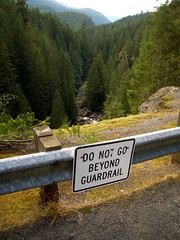Have you defined social media guidelines for your employees? If not, you might be an accident waiting to happen. Regardless of your company’s position in the spectrum of social media adoption, it’s way past the time when you should have defined the guard rails for your workforce regarding the use of social media inside and outside the enterprise. Even if you have a social media policy already, revisiting it often is a must, because the landscape keeps changing. Furthermore, you need to ask yourself (and your target audience), “How strict or how loose should you allow the guidelines to be?”

Image by Jeff Youngstrom via Flickr
Despite all the buzz around Enterprise 2.0, there are still plenty of companies out there that don’t have any intention to use blogs, YouTube, or Twitter any time soon. Many others are still timidly taking the first baby steps in that direction. Late adopters might just assume that they won’t need to establish social media guidelines until they start drinking the 2.0 Kool-Aid.
As we approach the one-year anniversary of the now infamous Domino Pizza video prank by two former employees, it’s concerning to know that very few companies have taken social media guidelines seriously. Considering that, even a year later, a Google search for “domino pizza video” will not bring a single result NOT related to that video on the first page, it’s safe to say that ensuring your employees are well aware of what’s OK and what’s off-limits when it comes to social media may be good for your brand. Remember, Domino’s didn’t intend to enter the social media world in that moment–their fame was thrust upon them with no guidelines, training, or preparation for their employees. Don’t let your entry into social media be accidental.
So, if you are late to the game, you might not want want to start your social media guidelines with a blank sheet. Chris Boudreaux keeps an excellent list of social media policies at SocialMediaGovernance.com that serves as a handy reference when drafting your own.
Make sure that you don’t take the easy route and just copy one of them. Ideally, these policies should fit your company’s profile and workforce, and one size definitely does not fit all. I really liked the process IBM used to define their social computing guidelines: capturing ideas from the whole community on a wiki, then running it by legal, and revisiting the policy often after that using other social media channels, like blogs and social file sharing.
Once your guidelines are ready for prime time, socialize them widely, and include them in the overall business conduct guidelines training. Don’t forget that the occasional user of social media might be more likely than many of your early adopters to violate the guidelines due to lack of awareness.
Finally, define a mechanism to monitor and enforce the guidelines. For internal usage, I prefer to let the community auto-regulate when it’s important to intervene, but I also recognize that this may not be appropriate in some cases. As I wrote a few years ago in another blog:
(…) don’t enforce guidelines as if you were the
police. Do it as if you were a parent. People will occasionally
post content that will challenge some of the guidelines. Unless it’s
blatantly inappropriate, you may be better off leaving it there for a
while, for the community to make a judgement. Sometimes breaking a
guideline says more about the guideline than about the violator, and
guidelines are supposed to evolve with the maturity of the blogging
community.
In next month’s post, I’ll discuss in more detail the process of refining guidelines. Stay tuned!

![Reblog this post [with Zemanta]](http://img.zemanta.com/reblog_e.png?x-id=030a55be-5ead-4033-8675-e1bd0234b689)



